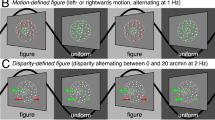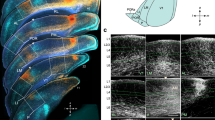Summary
The effects of lesions in the striate or extra-striate visual cortex of cats were evaluated using visual discrimination problems which required either local or global pattern processing. The results indicate that damage to areas 17 and 18 preferentially impairs local processes, while in addition they suggest that damage to the extra-striate cortex preferentially affects global processing. These findings may be related to the observations that cats with large lesions in the extra-striate cortex demonstrate deficits in form perception without reductions in visual acuity and those with lesions in areas 17–18 show elevations of acuity thresholds while maintaining excellent pattern and form vision.
Similar content being viewed by others
References
Benson DF, Greenberg JP (1969) Visual form agnosia, a specific deficit in visual descrimination. Arch Neurol 20: 82–89
Berkley MA, Sprágue JM (1979) Striate cortex and visual acuity functions in the cat. J Comp Neurol 187: 679–702
Berkley MA, Sprágue JM (1982) Role of the geniculocortical system in spatial vision. In: Ingle DJ, Goodale MA, Mansfield JW (eds) Analysis of visual behavior. MIT Press, Cambridge MA, pp 525–547
Berlucchi G, Sprágue JM (1981) The cerebral cortex in visual learning and memory, and in interhemispheric transfer in the cat. In: Schmitt FO, Worden FG, Adelman G, Dennis SG (eds) The organization of the cerebral cortex. MIT Press, Cambridge MA, pp 415–440
Broadbent DE, Broadbent MHP (1975) General shape and local detail in word perception. In: Dornic S (ed) Attention and performance, Vol VI. Lawrence Erlbaum Assoc, Hillsdale NJ, pp 489–504
Buchtel HA (1969) Visual form discrimination on the basis of the relative distribution of light. Science 164: 857–858
Campbell AJr (1978) Deficits in visual learning produced by posterior temporal lesions in cats. J Comp Physiol Psychol 92: 45–57
Cornwell P, Warren JM, Nonneman AJ (1976) Marginal and extramarginal cortical lesions and visual discriminations by cats. J Comp Physiol Psychol 90: 986–995
Cornwell P, Overman W, Campbell A (1980) Subtotal lesions of the visual cortex impair discrimination of hidden figures by cats. J Comp Physiol Psychol 94: 289–304
Cornwell P, Overman W, Ross C (1980) Lesions of visual cortex impair discrimination of hidden figures in cats. Physiol Behavior 24: 533–540
Cornwell P, Warren JM (1981) Visual discrimination defects in cats with temporal or occipital decortications. J Comp Physiol Psychol 95: 603–614
Denny-Brown D, Chambers RA (1958) The parietal lobes and behavior. Res Pub Assoc Res Nerv Ment Dis 36: 35–117
Dinéen J, Keating EG (1981) The primate visual system after bilateral removal of striate cortex. Exp Brain Res 49: 338–345
Doty RW (1971) Survival of pattern vision after removal of the striate cortex in the adult cat. J Comp Neurol 143: 341–369
Gellermann LW (1933) Chance order of alternating stimuli in visual discrimination experiments. J Gen Psychol 42: 206–207
Ginsberg A (1977) Visual information processing based upon spatial filters constrained by biological data. Ph.D. Dissertation, University of Cambridge
Guillery RW (1970) The laminar distribution of retinal fibers in the dorsal lateral geniculate nucleus of the cat: a new interpretation. J Comp Neurol 138: 339–368
Hara K, Cornwell PR, Warren JM, Webster IH (1974) Posterior extramarginal cortex and visual learning by cats. J Comp Physiol Psychol 87: 884–904
Harlow CA, Conners RW (1979) Image analysis segmentation methods. In: Fu KS, Pavlids T (eds) Biomedical pattern recognition and image processing. Verlag Chemie, Weinheim, pp 111–130
Heitlander-Fansa H (1982) Detection performance of cats lacking areas 17 and 18: a behavioural approach to analyze pattern recognition deficits. Ph.D. Dissertation, Zoologisches Institut der Universität Mainz, Mainz, West Germany
Hickey TL, Guillery RW (1974) An autoradiographic study of retinogeniculate pathways in the cat and fox. J Comp Neurol 156: 239–254
Hoffmann KP, von Seelen W (1984) Performance in the cat's visual system: a behavioral and neurophysiological analysis. Behav Brain Res 12: 101–120
Hughes HC (1977) Anatomical and neurobehavioral investigations concerning the thalamo-cortical organization of the rat's visual system. J Comp Neurol 175: 311–336
Hughes HC (1980) Efferent organization of the cat pulvinar complex, with a note on bilateral claustro-cortical and reticulo-cortical connections. J Comp Neurol 193: 937–964
Hughes HC, Layton WM, Baird JC, Sullivan L (1984) Global precedence in visual pattern recognition. Percept Psychophys 35: 361–371
Humphrey NK (1974) Vision in a monkey without striate cortex: a case study. Perception 3: 241–255
Kabrisky M, Tallman O, Day CM, Radoy CM (1970) Theory of pattern perception based on human physiology. Ergonomics 13: 129–142
Kahneman D, Henik A (1975) Effects of visual grouping on immediate recall and selective attention. In: Dornic S (ed) Attention and performance, Vol VI. Lawrence Erlbaum Assoc, Hillsdale NJ, pp 307–332
Kelly MD (1971) Edge detection in pictures using planning. In: Meltzer B, Michie D (eds) Machine intelligence, Vol 6. Halsted Press, New York, pp 397–409
Killackey H, Snyder M, Diamond IT (1971) Function of striate and temporal cortex in the tree shrew. J Comp Physiol Psychol 74: 1–29
Laties AM, Sprágue JM (1966) The projection of optic fibers to the visual centers in the cat. J Comp Neurol 127: 35–70
Lehmkuhle S, Kratz KE, Sherman SM (1982) Spatial and temporal sensitivity of normal and amblyopic cats. J Neurophysiol 48: 372–387
Levey NH, Harris J, Jane JA (1973) The effects of visual cortical ablation on pattern discrimination in the ground squirrel (Citellus tridecemlineatus). Exp Neurol 39: 270–276
Marr D (1976) Early processing of visual information. Philos Trans R Soc Lond (Series B) 275: 483–524
Mason R (1978) Functional organization in the cat's pulvinar complex. Exp Brain Res 31: 51–66
Mayhew JEW, Frisby JP (1978) Texture discrimination and Fourier analysis in human vision. Nature 275: 438–439
Meyer DR, Treichler FR, Meyer PM (1965) Discrete-trial training techniques and stimulus variables. In: Schrier AM, Harlow HF, Stollnitz F (eds) Behavior of non-human primates: modern research trends, Vol 1. Academic Press, New York, pp 1–49
Miller J (1981) Global precedence in attention and decision. J Exp Psychol Human Percept Perf 9: 353–383
Navon D (1977) Forest before the trees: the precedence of global features in visual perception. Cogn Psychol 9: 353–383
Niimi K, Kuwahara E (1973) The dorsal thalamus of the cat and comparison with monkey and man. J Hirnforsch 14: 303–325
Niimi K, Sprágue JM (1969) Thalamo-cortical organization of the visual system in the cat. J Comp Neurol 138: 219–250
Otsuka R, Hassler R (1962) Über Aufbau und Gliederung der corticalen Sehsphäre bei der Katze. Arch Psychiat Z Neurol 203: 212–234
Palmer LA, Rosenquist AC, Tusa RJ (1978) The retinotopic organization of lateral suprasylvian visual areas in the cat. J Comp Neurol 177: 237–256
Pasik P, Pasik T, Schilder P (1969) Extrageniculostriate vision in the monkey: discrimination of luminous, flux-equated figures. Exp Neurol 24: 421–437
Raczkowski D, Rosenquist AC (1980) Connections of the parvocellular C laminae of the dorsal lateral geniculate nucleus with the visual cortex in the cat. Brain Res 199: 447–451
Raczkowski D, Rosenquist AC (1983) Connections of the multiple visual cortical areas with the lateral posterior-pulvinar complex and adjacent thalamic nuclei in the cat. J Neurosci 3: 1912–1942
Ritchie GO, Meyer PM, Meyer DR (1976) Residual spatial vision of cats with lesions of the visual cortex. Exp Neurol 53: 227–253
Sanderson KJ (1971) The projection of the visual field to the lateral geniculate and medial interlaminar nuclei in the cat. J Comp Neurol 143: 101–118
Sanides F, Hoffmann J (1969) Cytoand myeloarchitecture of the visual cortex of the cat and of the surrounding integration cortices. J Hirnforsch 11: 79–104
Sherman SM (1973) Visual field defects in monocularly and binocularly deprived cats. Brain Res 49: 25–45
Sherman SM (1985) Functional organization of the w-, x-, and y-cell pathways in the cat: a review and hypothesis. In: Sprágue JM, Epstein AN (eds) Progress in psychobiology and physiological psychology, Vol 11. Academic Press, New York (in press)
Spear PD (1979) Behavioral and neurophysiological consequences of visual cortex damage: mechanisms of recovery. In: Sprágue JM, Epstein AN (eds) Progress in psychobiology and physiological psychology, Vol 8. Academic Press, New York, pp 45–90
Spear PD, Bauman TP (1979) Effects of visual cortex removal on receptive field properties of neurons in the lateral suprasylvian visual area of the cat. J Neurophysiol 42: 31–56
Spear PD, Barbas H (1975) Recovery of pattern discrimination ability in rats receiving serial or one-stage visual cortex lesions. Brain Res 94: 337–346
Spear PD, Braun JJ (1969) Pattern discrimination following removal of visual neocortex in the cat. Exp Neurol 25: 331–348
Spear PD, Miller S, Ohman L (1983) Effects of lateral suprasylvian visual cortex lesions on visual localization, discrimination, and attention in cats. Behav Brain Res 10: 339–359
Sprágue JM, Berkley M, Tunkl J, Berlucchi G (1976) Neural mechanisms mediating pattern and form discriminations in the cat. Soc Neurosci Abstr 2: 1093
Sprágue JM, Hughes HC, Berlucchi G (1981) Cortical mechanisms in form perception. In: Pompeiano O, Ajmone-Marsan C (eds) Brain mechanisms and perceptual awareness. Raven Press, New York, pp 107–132
Sprágue JM, Levy J, DiBerardino A, Berlucchi G (1977) Visual cortical areas mediating form discrimination in the cat. J Comp Neurol 172: 441–488
Sprágue JM, Meikle TH (1965) The role of the superior colliculus in visually guided behavior. Exp Neurol 11: 115–146
Symonds LL, Rosenquist AC (1985) Cortico-cortical connections among visual areas in the cat. J Comp Neurol (in press)
Symonds LL, Rosenquist AC, Edwards SB, Palmer LA (1981) Projections of the pulvinar-lateral posterior complex to the visual cortical areas in the cat. Neuroscience 6: 1995–2020
Taylor AM, Warrington EK (1973) Visual discrimination in patients with localized cerebral lesions. Cortex 9: 82–93
Tusa RJ, Palmer LA, Rosenquist AC (1981) Multiple cortical visual areas; visual field topography in the cat. In: Woolsey CN (ed) Cortical sensory organization, Vol 2. Humana Press, New Jersey
Tusa RJ, Palmer LA (1980) Retinotopic organization of areas 20 and 21 in the cat. J Comp Neurol 193: 147–164
Tusa RL, Palmer LA, Rosenquist AC (1978) The retinotopic organization of area 17 (striate cortex) in the cat. J Comp Neurol 177: 213–236
Tusa RJ, Rosenquist AC, Palmr LA (1979) Retinotopic organization of areas 18 and 19 in the cat. J Comp Neurol 185: 657–678
Updyke BV (1977) Topographic organization of the projections from cortical areas 17, 18 and 19 onto the thalamus, pretectum and superior colliculus in the cat. J Comp Neurol 173: 81–122
Warrington EK, James M (1967) Disorders of visual perception in patients with localized cerebral lesions. Neuropsychologia 5: 253–266
Warrington EK, Taylor AM (1973) The contribution of the right parietal lobe to object recognition. Cortex 9: 152–164
Winans SS (1971) Visual cues used by normal and visual decorticate cats to discriminate figures of equal luminance flux. J Comp Physiol Psychol 74: 167–178
Wood CC, Spear PD, Braun JJ (1974) Effects of sequential lesions of suprasylvian gyri and visual cortex on pattern discrimination in the cat. Brain Res 66: 443–466
Author information
Authors and Affiliations
Rights and permissions
About this article
Cite this article
Hughes, H.C., Sprágue, J.M. Cortical mechanisms for local and global analysis of visual space in the cat. Exp Brain Res 61, 332–354 (1986). https://doi.org/10.1007/BF00239523
Received:
Accepted:
Issue Date:
DOI: https://doi.org/10.1007/BF00239523




